UPDATE - Kleiner’s Korner: The Motor Parkway and the Vanderbilt Cup Race in Literature and Entertainment (Part 2)
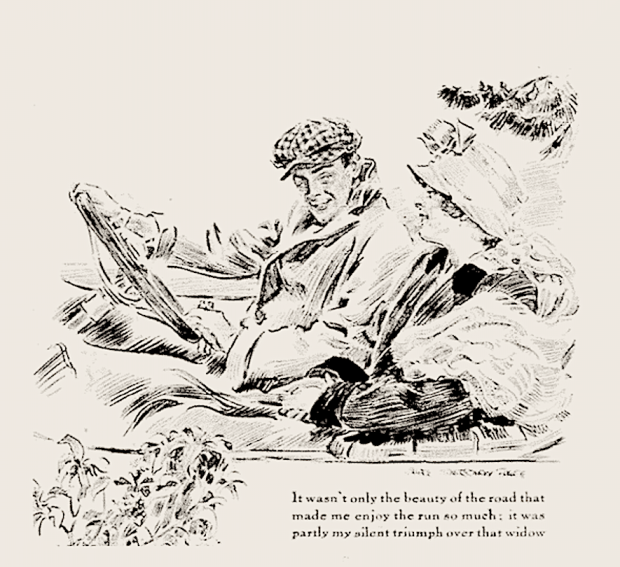
Writers of fiction included references to our favorite roadway and race to set the atmosphere of where their stories took place or to add an element of excitement. Rarely were references used more than once in a particular work unless they were a major component of the literary work. Enjoy reading what I've been able to find.
Art Kleiner
UPDATE" "The Auction Block"
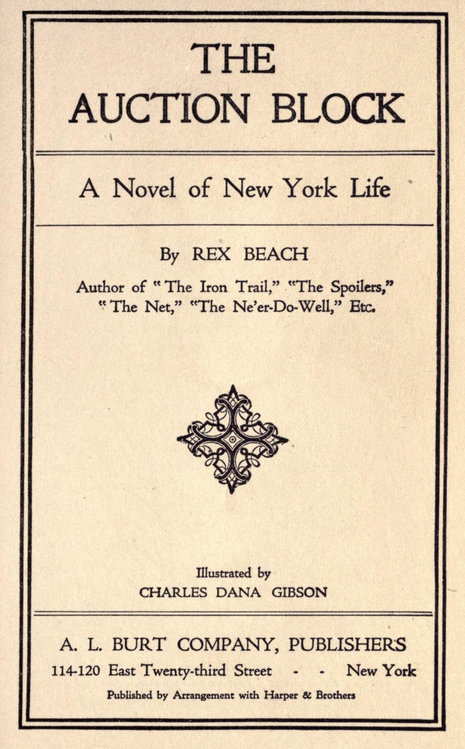
Thanks to Al Velocci, the earliest mention of the Motor Parkway in a literary work I've found came in a "social" novel titled "The Auction Block" written by Rex Beach and published in 1914. Incidentally, Beach began his writing career after 5 years of failing as a gold prospector in Alaska. Hopefully writing gave him more success. (The Auction Block, 1914)

The novel was made into a movie in 1917 with a 1926 remake. Unfortunately, no copies of either film, which probably would have scenes depicting the Motor Parkway, have been found.
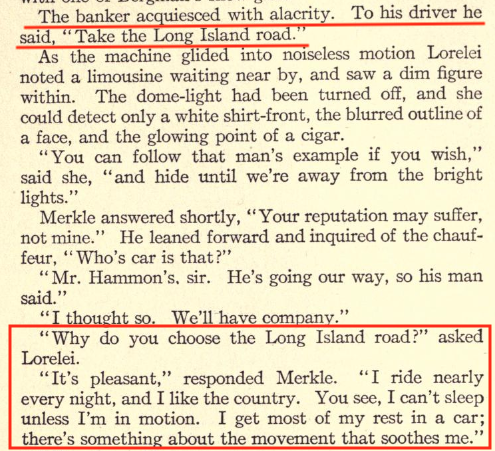
The book mentions the Motor Parkway in a few passages as the characters ride on it on their travels on Long Island. (The Auction Block, 1914)
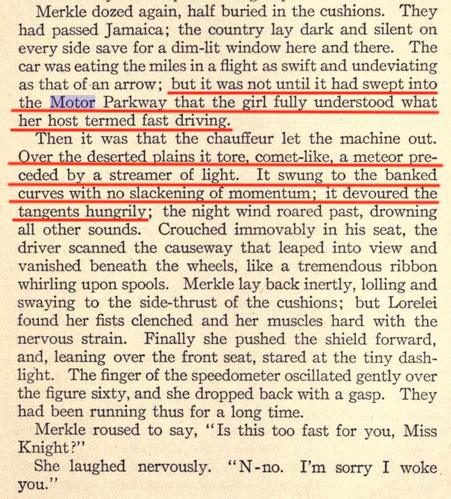
Even mentioning the parkway's banked curves. (The Auction Block, 1914)
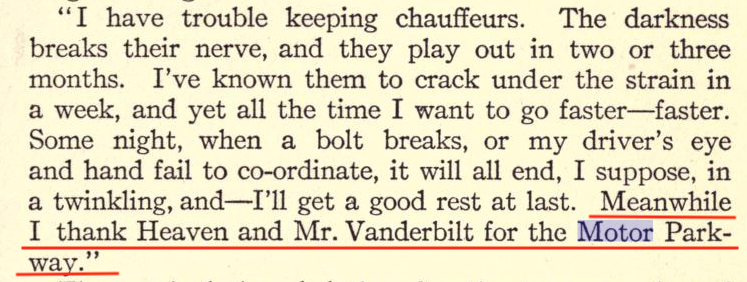
And thanking Willie K. (along with Heaven) for building the road.
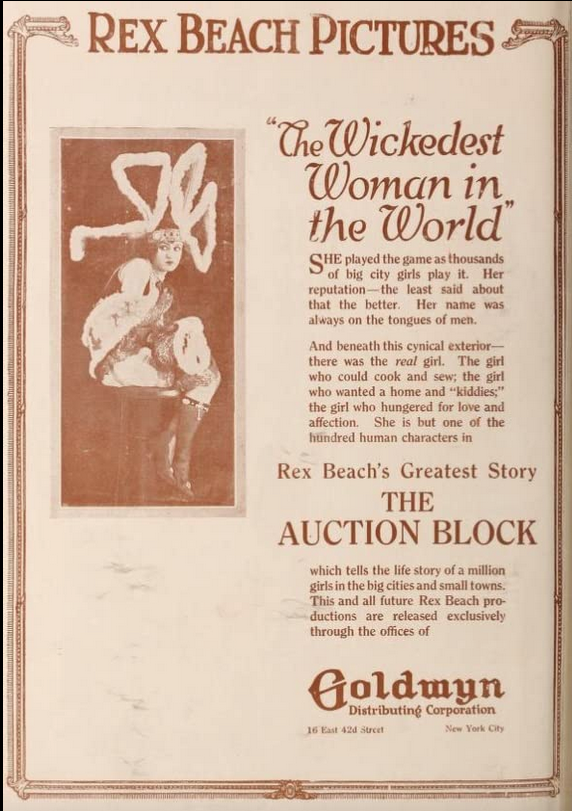
Advertisement for the original silent film production. (IMDB.com)

The film contained several scenes in which the Chicago Board of Censors objected. (Exhibitors Herald Company Dec. 29, 1917)
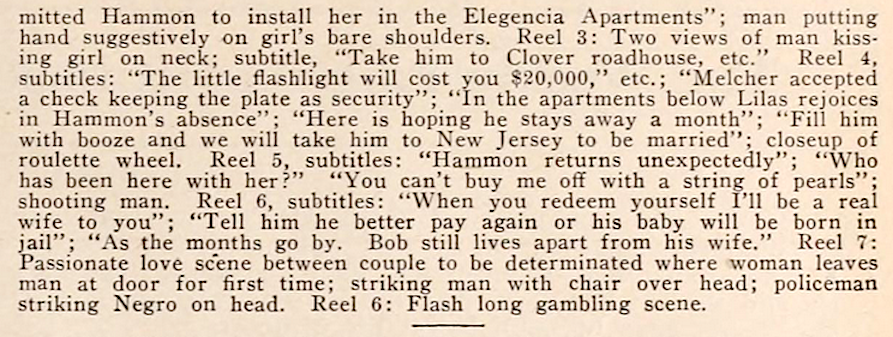
Hopefully none containing the Motor Parkway! (Exhibitors Herald Company Dec. 29, 1917)
"The Adventures of Jose"
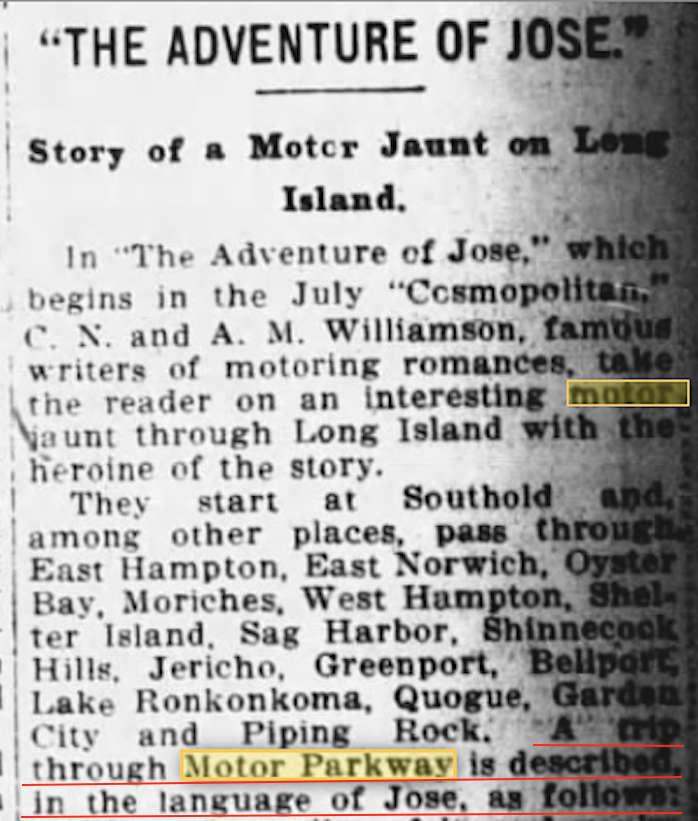
Long Island and the Motor Parkway were prominently featured in a story published in "Cosmopolitan" magazine in 1917. The story was reviewed by the Brooklyn Citizen which included several applicable passages. (Brooklyn Citizen Jun. 17, 1917)
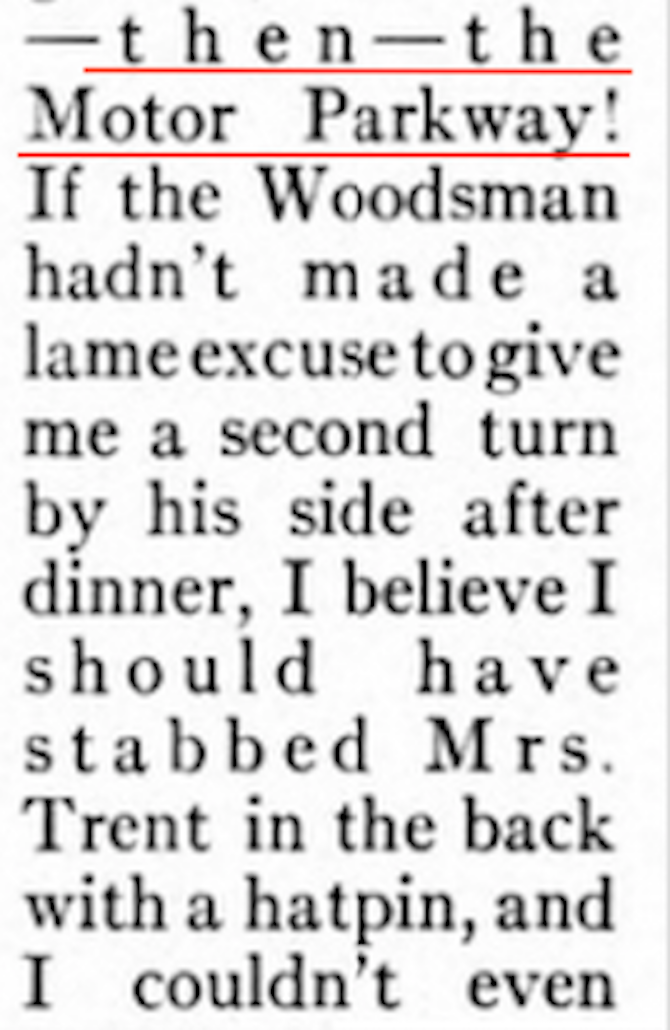
The actual article appeared in "Cosmopolitan" in July and August, 1917. (Cosmopolitan Jul., 1917)
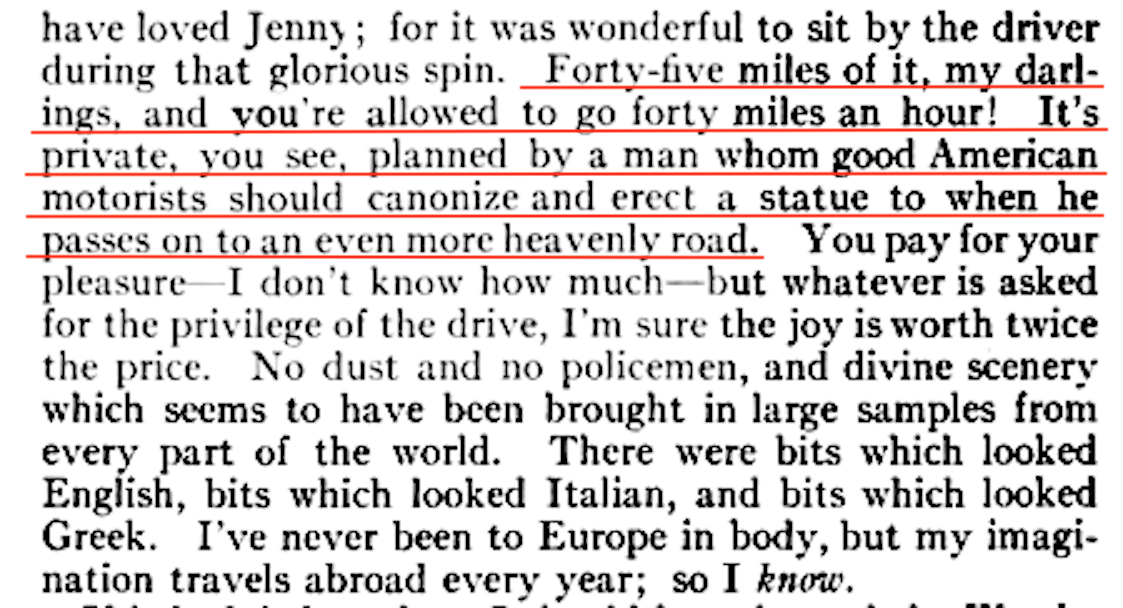
Kudos were given to Willie K. (I'm assuming) by the author. (Cosmopolitan Jul., 1917)
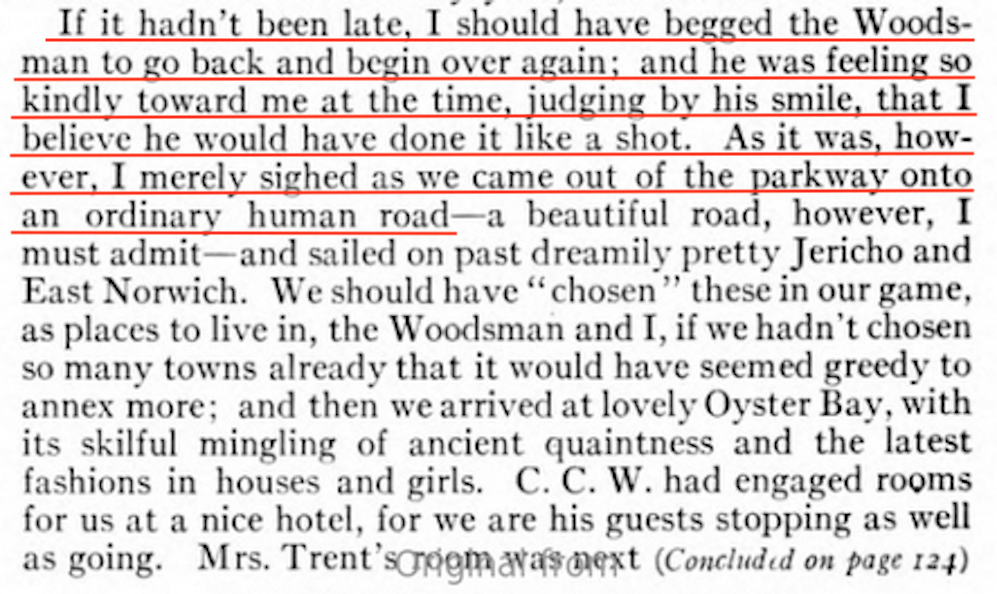
Other LI roads were merely "ordinary human" roads. (Cosmopolitan Jul., 1917)
"The Conquest of America"
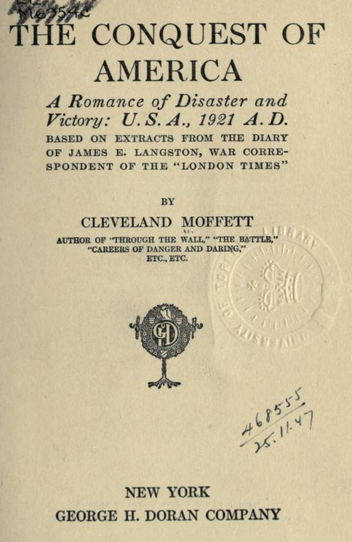
Following the end of WWI this literary work described the fictional invasion of Long Island by German troops as a statement to ensure the military preparedness of the United States. (The Conquest of America, 1921)
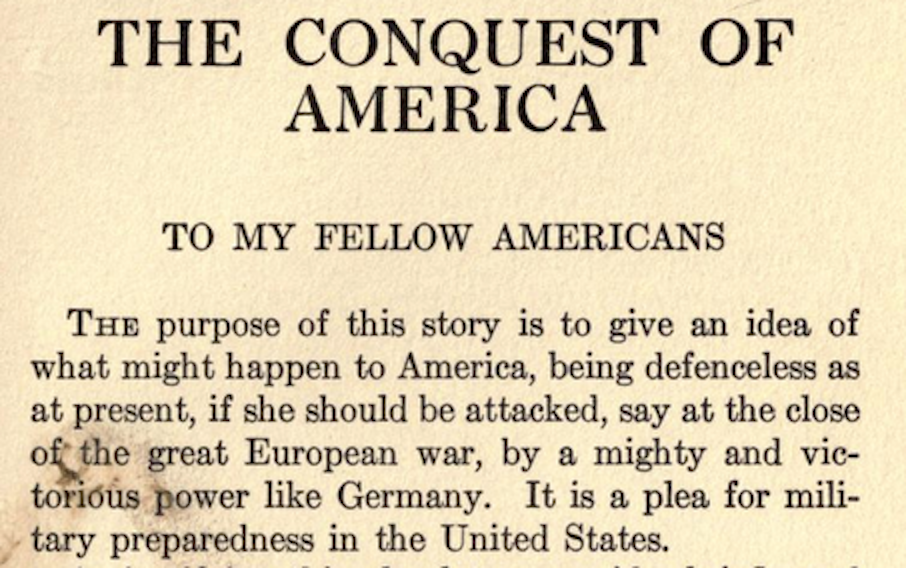

150,000 German troops marching along the Motor Parkway! (The Conquest of America, 1921)
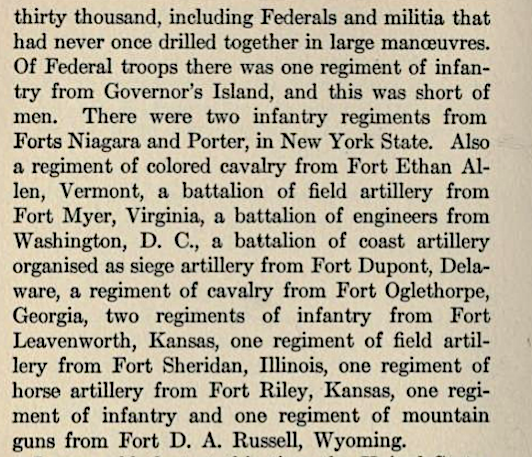
You'll need to read the whole book courtesy of the InternetArchive to see how it ends! (The Conquest of America, 1921)
"On Wing's of Wireless"
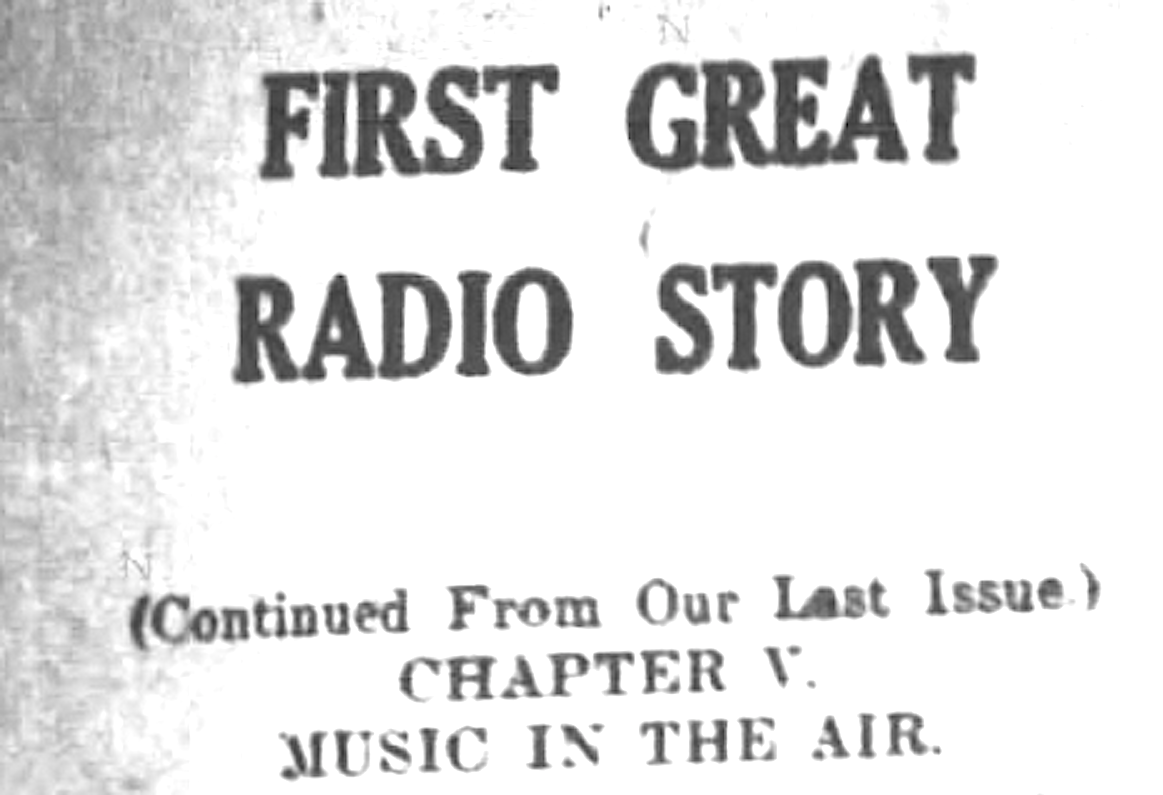
This chapter is from a story titled "On Wing's of Wireless" written in 1922 by Arthur B. Reeves (1880-1936) and which was published in numerous newspapers across America. Reeves was born in Patchogue, NY and specialized in detective stories, whose character, Craig Kennedy, was referred to by the press as the American Sherlock Holmes. Reeves was similarly called the American Conan Doyle. (Brooklyn Citizen Jun. 9, 1922)
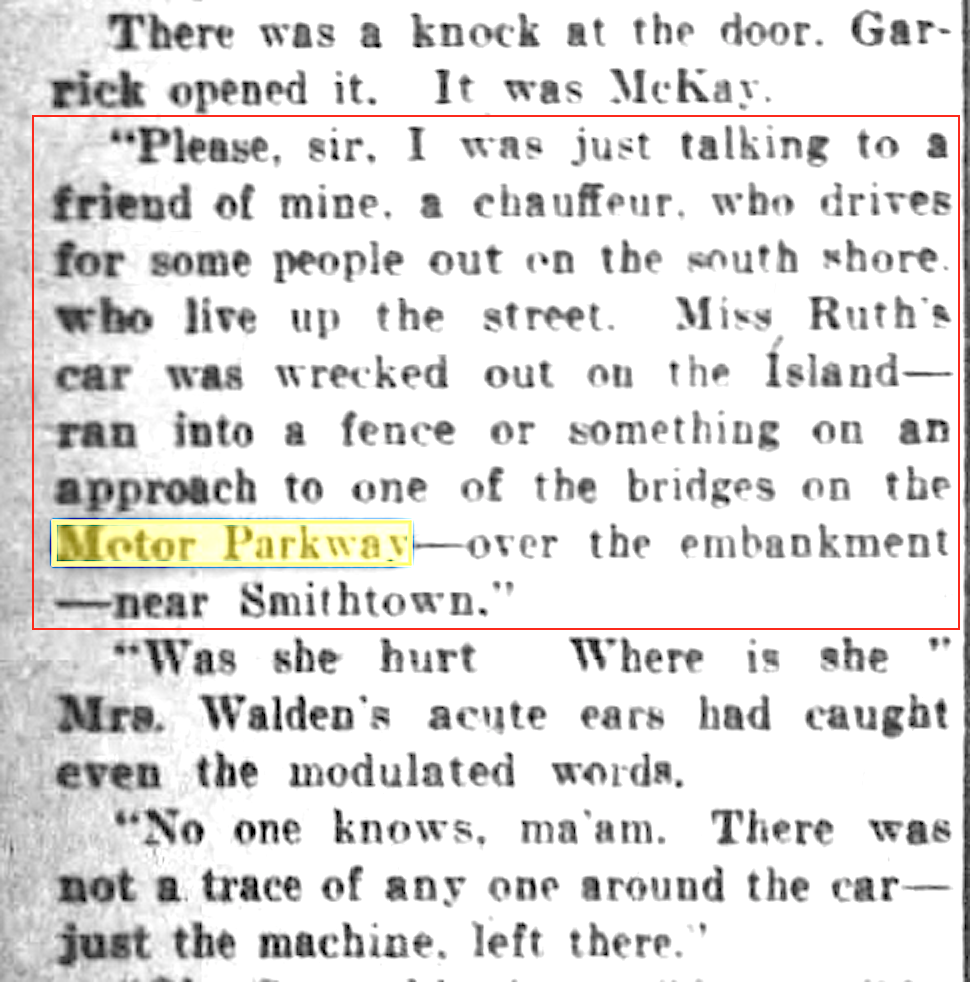
However, the story of which the Motor Parkway appears is from a series of works by Reeves whose main character is Detective Guy Garrick. Having been born on LI Reeves used his knowledge of the area in his stories, at least in the one noted here. Any idea on which bridge the accident took place? (Brooklyn Citizen Jun. 9, 1922)
"The Bainbridge Murders"
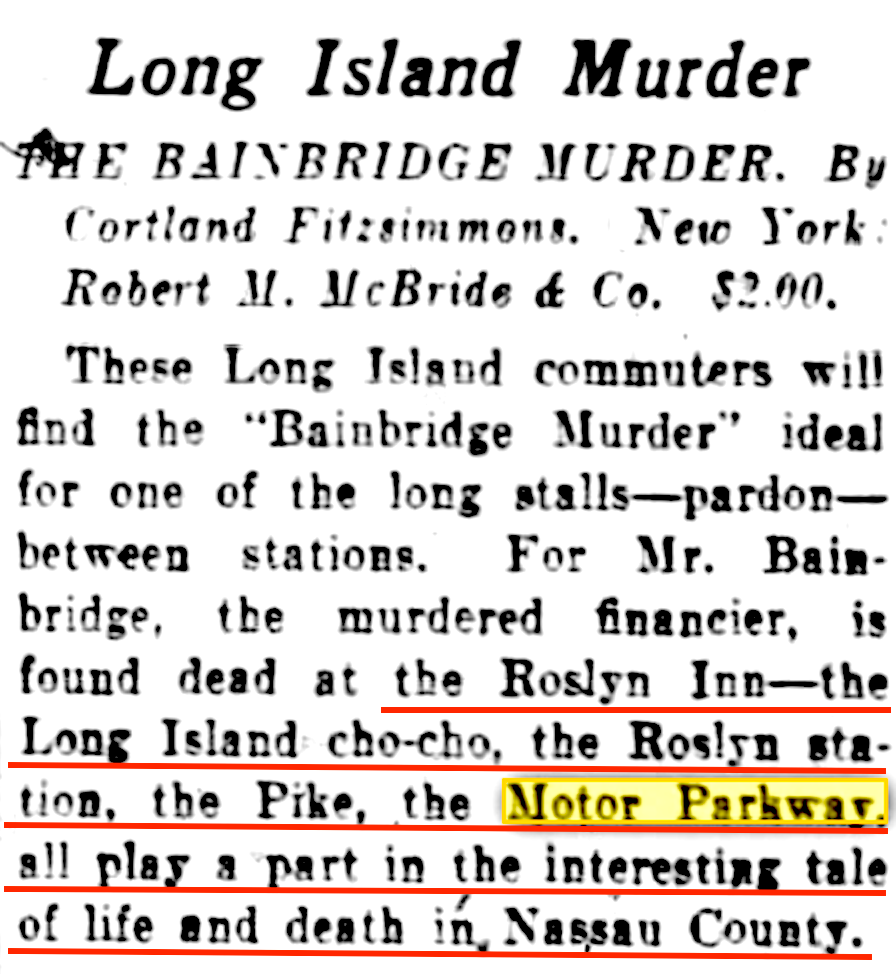
Another novel in which Long Island (Roslyn in particular) and the Motor Parkway were prominently featured. (Brooklyn Citizen Jan. 10, 1930)
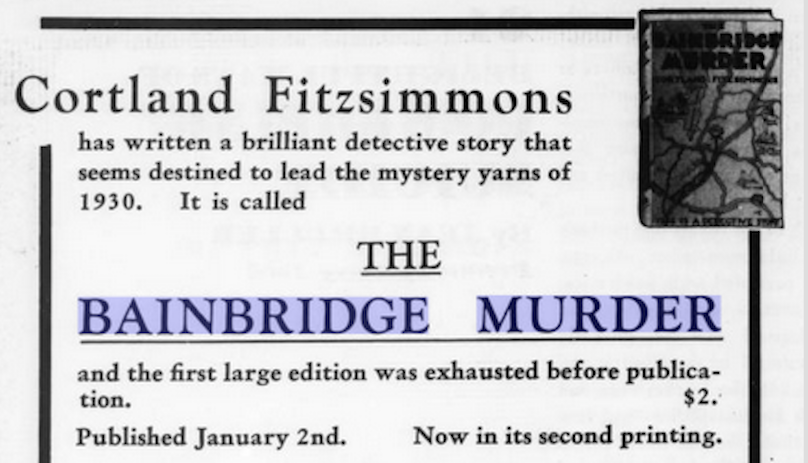
An advertisement for "The Bainbridge Murder" (The Publishers Weekly Jan. 4, 1930)
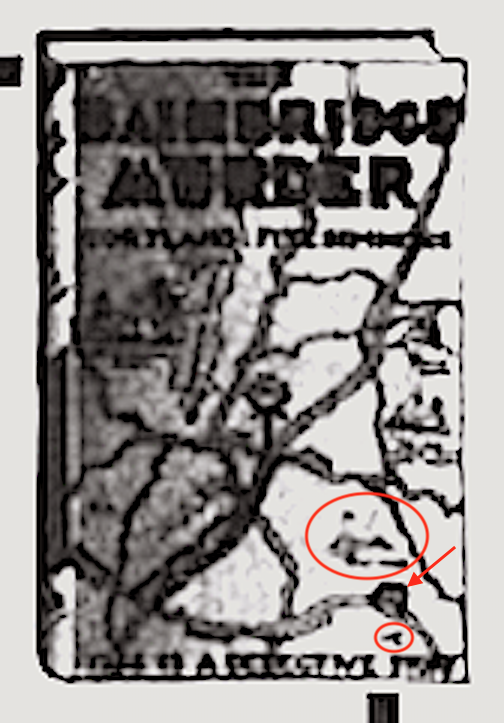
The jacket cover of the book was a map depicting the events of the murder. Is that Mr. Bainbridge with a knife in his back near a Motor Parkway bridge, the Motor Parkway itself and an airplane? Definitely need to find a copy of the cover to confirm!
"The Motor Parkway Murder"
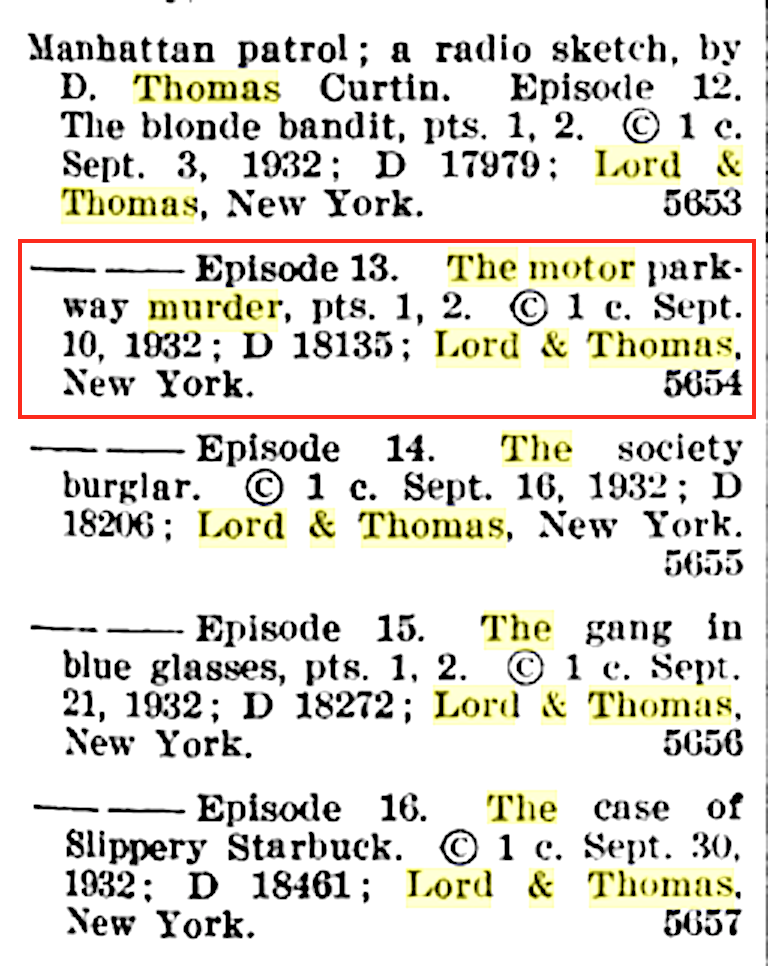
Although I don't have the script of episode 13 of this radio sketch, its name would obviously indicate some relevance to the Motor Parkway. Lord and Thomas was one of the largest US advertising agencies which today is named Foote, Cone & Belding. (Catalog of Copyright Entries, 1932)
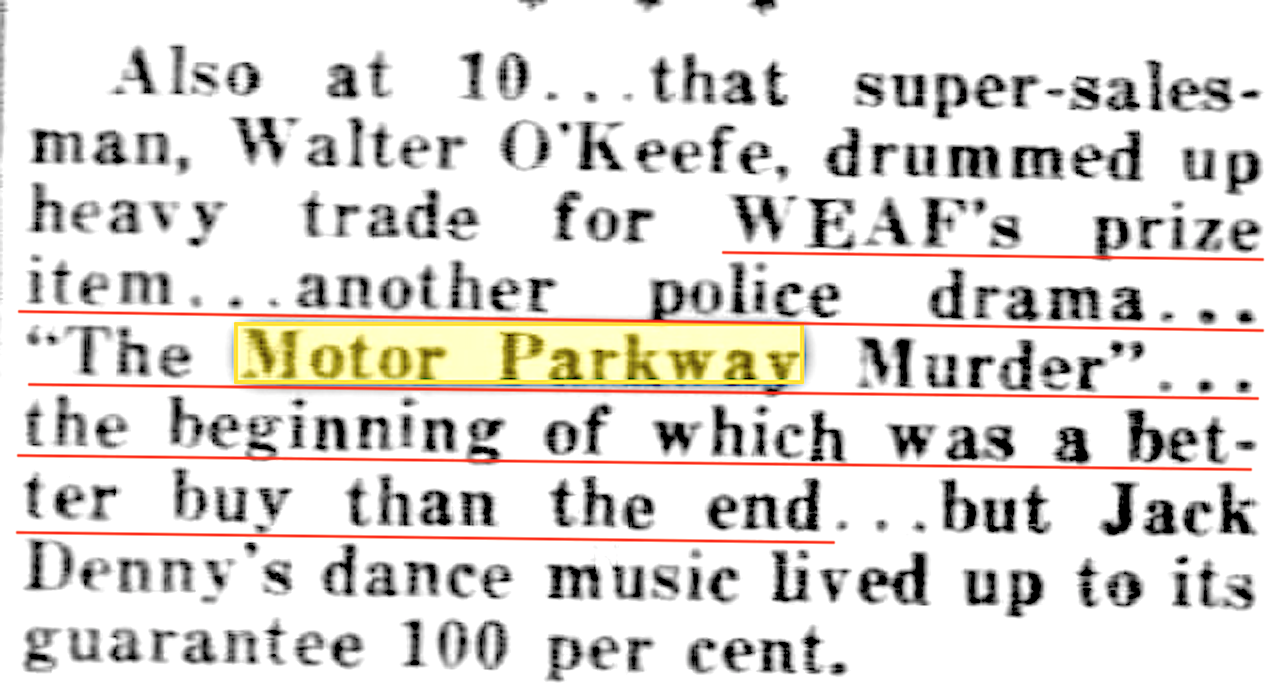
Advertising agencies often sponsored radio sketches in order to promote their brands. WEAF, an early radio station with studios in NY and transmitters on Maple Avenue in Bellmore (and later in Port Washington), broadcast "The Motor Parkway Murders" not far from the scene of the crime. (NY Daily News Sept. 14, 1932, theradiohistorian.org)
"Internal Revenue"
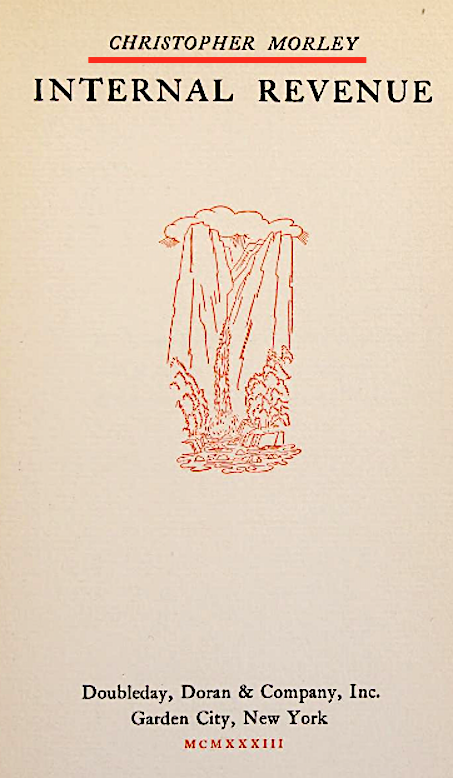
Roslyn's Christopher Morley was an American journalist, author and essayist who penned over 100 literary works, including this one which mentioned the Motor Parkway. Morley lived in Roslyn Estates, approximately three miles form the Roslyn Lodge entrance to the Motor Parkway. (Internal Revenue, 1933)
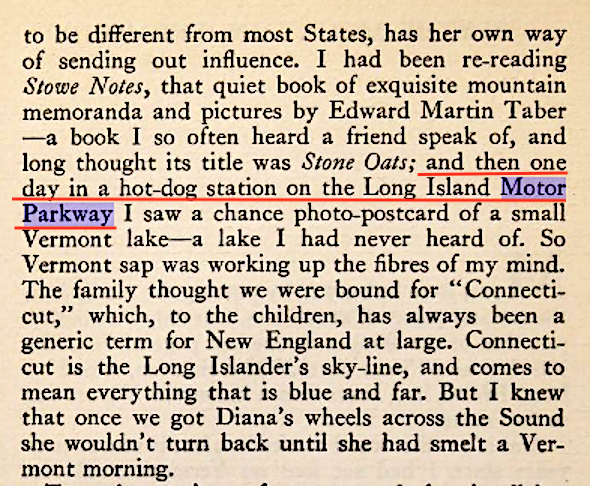
A "hot-dog station on the Long Island Motor Parkway" - could this have been the refreshment stand in Central Park (Bethpage) near Deadman's Curve? (Internal Revenue, 1933)
"Salamis and the Ugly Ducking"

Morley contributed to the publication issued by the Long Island Rail Road and mentioned the Motor Parkway in this article. The Salamis reference is the historic village near his home-Roslyn. (LIRR Bulletin Jul., 1925)
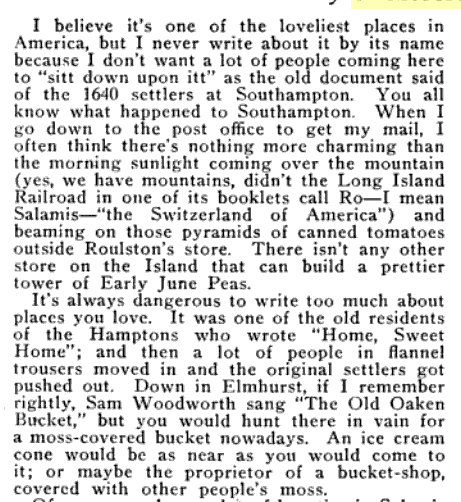
LIRR Bulletin Jul., 1925
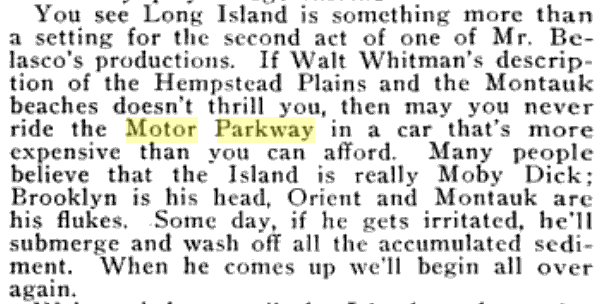
LIRR Bulletin Jul., 1925
"Wheel of Fortune" (no, not the game show)
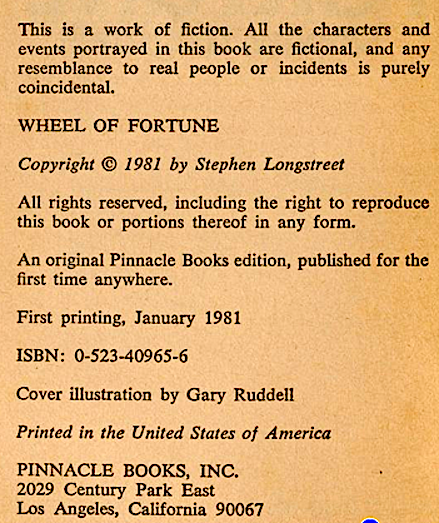
More recent authors have used the Motor Parkway in their works as shown in this 1981 novel. (Wheel of Fortune, 1981)
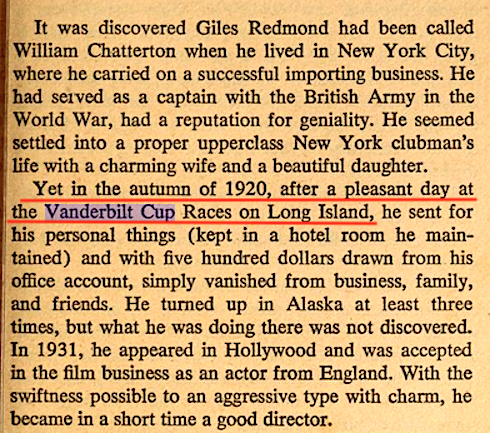
As stated above, the story is a work of fiction. I guess the author writing that the Vanderbilt Cup Race on Long Island took place in 1920 would bear this out! (Wheel of Fortune, 1981)
"Ladies of the Goldfield Stock Exchange"
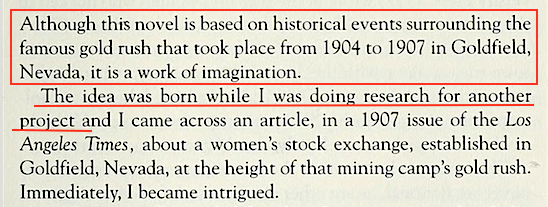
While researching for another book, this author came across information that laid the basis of this 1981 novel which takes place in a location that I've previously written about - Goldfield, Nevada. (Ladies of the Goldfield Stock Exchange, 1997)
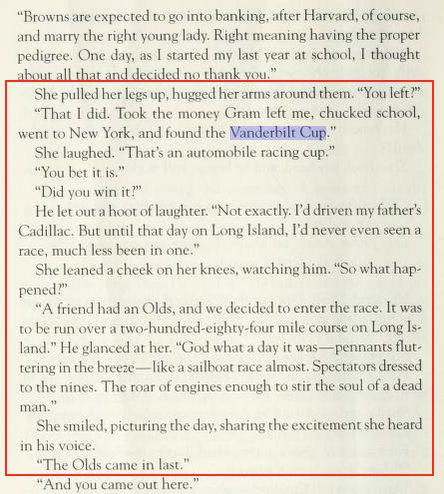
Interestingly the author mentions the Vanderbilt Cup Race in one chapter. "The roar of engines enough to stir the soul of a dead man." "The Olds came in last." (Ladies of the Goldfield Stock Exchange, 1997)
"Murder in Hollywood"
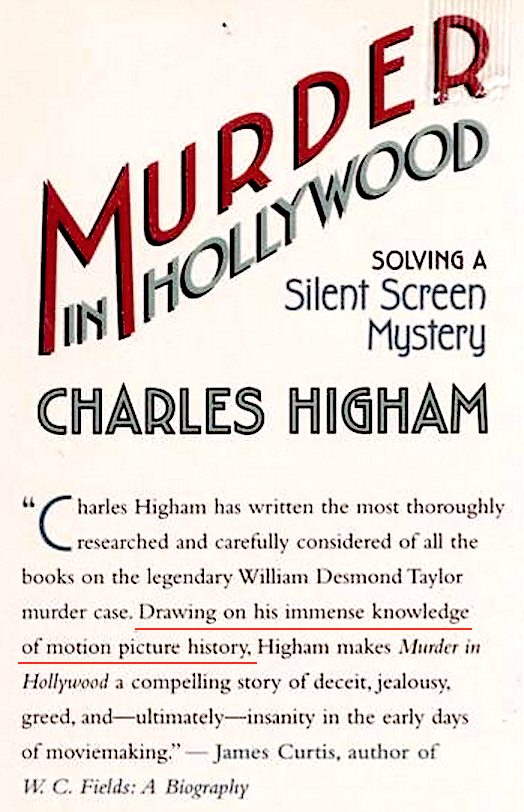
The author of this novel might have an immense knowledge of motion picture history but not the history of the Motor Parkway or the Vanderbilt Cup Race. (Murder in Hollywood, 2004)
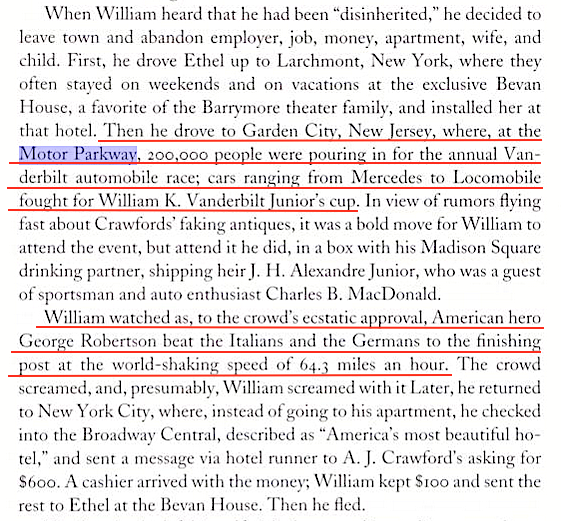
Garden City, New Jersey? Although he did appear to get other aspects of the race correct. (Murder in Hollywood, 2004)
I hope this review of the Motor Parkway and The Vanderbilt Cup Race in literature brought you some enjoyable reading. I'll always be on the look out for more references, regardless of the medium - let the rest of the readership know if you find any as well.

Comments
I imagining some of these writings being factual, especially the enemy troops marching into NYC via the LIMP, maybe some military vehicles too. Nearest bridge to Smithtown was over Deer Park Ave. Maybe the author had knowledge of the planned but never built bridges : ) Fun & interesting research Art, thanks.
Art, I believe the earliest reference to the Motor Parkway in a fiction work was in 1914 in The Auction Block by Rex Beach.
Thanks to Al Velocci’s comment above, I’ve updated this post to include information about the first mention of the Motor Parkway in a work of literature. Thanks Al!
And Happy New Year’s to all!
This seems to be a real trip by fictional characters. THE LIGHTNING CONDUCTOR DISCOVERS AMERICA by C.N. & A.M. Williamson, 1916.
Howard,
I really enjoyed all the Motor Parkway stuff mentioned in the above articles. I finally learned who Christopher Morley was. Thanks
Roger
Thanks Dave for your comment on The “Lightning Conductor Discovers America”. Its married authors are Charles Norris and Alice Muriel Williamson who wrote many novels with Alice specializing in motor travel romances. Their first “Lighting Conductor” story was written in 1903 and was called “The Lightning Conductor: The Strange Adventures of a Motor Car” and took place in Europe. It was made into a movie in 1914 and was shown in America.
As you note the American version was written in 1916. In the passages that I’ve attached the beauty of Long Island the Motor Parkway allows the passenger to witness is described, along with praise for the builder of the parkway, although not named. Several pages of the story describe Long Island and mention the route taken.
The jacket cover of the book and the map of Long Island.
The above passages and map were from the book that can be downloaded at hathitrust.org. The jacket cover was from gutenberg.org.
WEAF mentioned above eventually became 66 WNBC. Today, it is All-Sports, WFAN.
Good Morning Art: Just looking around to see what Williamson books I have around here! Happy Motoring, Dave.
Nice collection Dave! Have you read them all? Here’s a list of their works from Wikipedia.
“Excuse My Dust” is another book with references to the Motor Parkway and the Vanderbilt Cup Race. Written in 1943 the author, Bellamy Partridge, details his past experiences with the automobile.
The book describes the author’s trip from NYC to LI and back.
Oswald Jacoby in his 1962 book “Mathemetics for Pleasure” used a race on the Motor Parkway between “Newcar” and “Jalopy” in one of his math problems. According to the author the race actually did occur in 1914.
One more literary work titled “The Tangled Web” included Long Island and the Vanderbilt Cup Race in its story. I’m not sure if it was mentioned already, but here’s an excerpt. The story was written by Ethel Watts Mumford Grant and appeared in “The New Broadway Magazine” of June, 1908.
The last section.